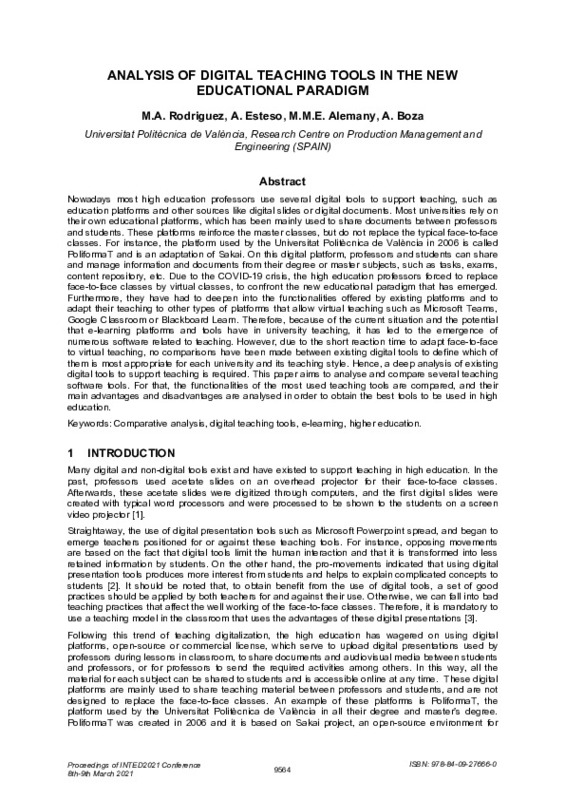JavaScript is disabled for your browser. Some features of this site may not work without it.
Buscar en RiuNet
Listar
Mi cuenta
Estadísticas
Ayuda RiuNet
Admin. UPV
Analysis of digital teaching tools in the new educational paradigm
Mostrar el registro sencillo del ítem
Ficheros en el ítem
| dc.contributor.author | Rodríguez-Sánchez, María De Los Ángeles
|
es_ES |
| dc.contributor.author | Esteso, Ana
|
es_ES |
| dc.contributor.author | Alemany Díaz, María Del Mar
|
es_ES |
| dc.contributor.author | Boza, Andres
|
es_ES |
| dc.date.accessioned | 2022-12-16T08:08:57Z | |
| dc.date.available | 2022-12-16T08:08:57Z | |
| dc.date.issued | 2021-03-09 | es_ES |
| dc.identifier.isbn | 978-84-09-27666-0 | es_ES |
| dc.identifier.issn | 2340-1079 | es_ES |
| dc.identifier.uri | http://hdl.handle.net/10251/190744 | |
| dc.description.abstract | [EN] Nowadays most high education professors use several digital tools to support teaching, such as education platforms and other sources like digital slides or digital documents. Most universities rely on their own educational platforms, which has been mainly used to share documents between professors and students. These platforms reinforce the master classes, but do not replace the typical face-to-face classes. For instance, the platform used by the Universitat Politècnica de València in 2006 is called PoliformaT and is an adaptation of Sakai. On this digital platform, professors and students can share and manage information and documents from their degree or master subjects, such as tasks, exams, content repository, etc. Due to the COVID-19 crisis, the high education professors forced to replace face-to-face classes by virtual classes, to confront the new educational paradigm that has emerged. Furthermore, they have had to deepen into the functionalities offered by existing platforms and to adapt their teaching to other types of platforms that allow virtual teaching such as Microsoft Teams, Google Classroom or Blackboard Learn. Therefore, because of the current situation and the potential that e-learning platforms and tools have in university teaching, it has led to the emergence of numerous software related to teaching. However, due to the short reaction time to adapt face-to-face to virtual teaching, no comparisons have been made between existing digital tools to define which of them is most appropriate for each university and its teaching style. Hence, a deep analysis of existing digital tools to support teaching is required. This paper aims to analyse and compare several teaching software tools. For that, the functionalities of the most used teaching tools are compared, and their main advantages and disadvantages are analysed in order to obtain the best tools to be used in high education. | es_ES |
| dc.description.sponsorship | This work has been developed within the framework of the projects Coordinación metodológica a través de webs de apoyo en títulos ETSII para diferentes Competencias Trasversales of the call for Educational Innovation and Improvement Projects (PIME) with code PIME/19-20 Ref. 150, Ref. 151 and Ref. 152, in its institutional modality, promoted by the Vice-Rectorate for Studies, Quality and Accreditation and the Institute of Education Sciences of the Universitat Politècnica de València. The first author was supported by the Generalitat Valenciana (Conselleria de Educación, Investigación, Cultura y Deporte) under Grant ACIF/2019/021. | es_ES |
| dc.language | Inglés | es_ES |
| dc.publisher | IATED Academy | es_ES |
| dc.relation.ispartof | INTED2021 Proceedings | es_ES |
| dc.rights | Reserva de todos los derechos | es_ES |
| dc.subject | Comparative analysis | es_ES |
| dc.subject | Digital teaching tools | es_ES |
| dc.subject | E-learning | es_ES |
| dc.subject | Higher education | es_ES |
| dc.subject.classification | ORGANIZACION DE EMPRESAS | es_ES |
| dc.title | Analysis of digital teaching tools in the new educational paradigm | es_ES |
| dc.type | Comunicación en congreso | es_ES |
| dc.type | Artículo | es_ES |
| dc.type | Capítulo de libro | es_ES |
| dc.identifier.doi | 10.21125/inted.2021.2000 | es_ES |
| dc.relation.projectID | info:eu-repo/grantAgreement///ACIF%2F2019%2F021//SISTEMA DE ANALISIS Y PREDICCION DE DATOS EN CADENAS DE SUMINISTRO AGRICOLAS, PARA LA MEJORA DE LA GESTION DE LA DEMANDA, MEDIANTE TECNICAS DE B./ | es_ES |
| dc.relation.projectID | info:eu-repo/grantAgreement/UPV//PIME%2F19-20%2F151/ | es_ES |
| dc.relation.projectID | info:eu-repo/grantAgreement/UPV//PIME%2F19-20%2F152/ | es_ES |
| dc.relation.projectID | info:eu-repo/grantAgreement/UPV//PIME%2F19-20%2F150/ | es_ES |
| dc.rights.accessRights | Abierto | es_ES |
| dc.contributor.affiliation | Universitat Politècnica de València. Escuela Técnica Superior de Ingenieros Industriales - Escola Tècnica Superior d'Enginyers Industrials | es_ES |
| dc.contributor.affiliation | Universitat Politècnica de València. Departamento de Organización de Empresas - Departament d'Organització d'Empreses | es_ES |
| dc.contributor.affiliation | Universitat Politècnica de València. Escola Tècnica Superior d'Enginyeria Informàtica | es_ES |
| dc.description.bibliographicCitation | Rodríguez-Sánchez, MDLÁ.; Esteso, A.; Alemany Díaz, MDM.; Boza, A. (2021). Analysis of digital teaching tools in the new educational paradigm. IATED Academy. 9564-9570. https://doi.org/10.21125/inted.2021.2000 | es_ES |
| dc.description.accrualMethod | S | es_ES |
| dc.relation.conferencename | 15th International Technology, Education and Development Conference (INTED2021) | es_ES |
| dc.relation.conferencedate | Marzo 08-09,2021 | es_ES |
| dc.relation.conferenceplace | Online | es_ES |
| dc.relation.publisherversion | https://doi.org/10.21125/inted.2021.2000 | es_ES |
| dc.description.upvformatpinicio | 9564 | es_ES |
| dc.description.upvformatpfin | 9570 | es_ES |
| dc.type.version | info:eu-repo/semantics/publishedVersion | es_ES |
| dc.relation.pasarela | S\432118 | es_ES |
| dc.contributor.funder | Universitat Politècnica de València | es_ES |








